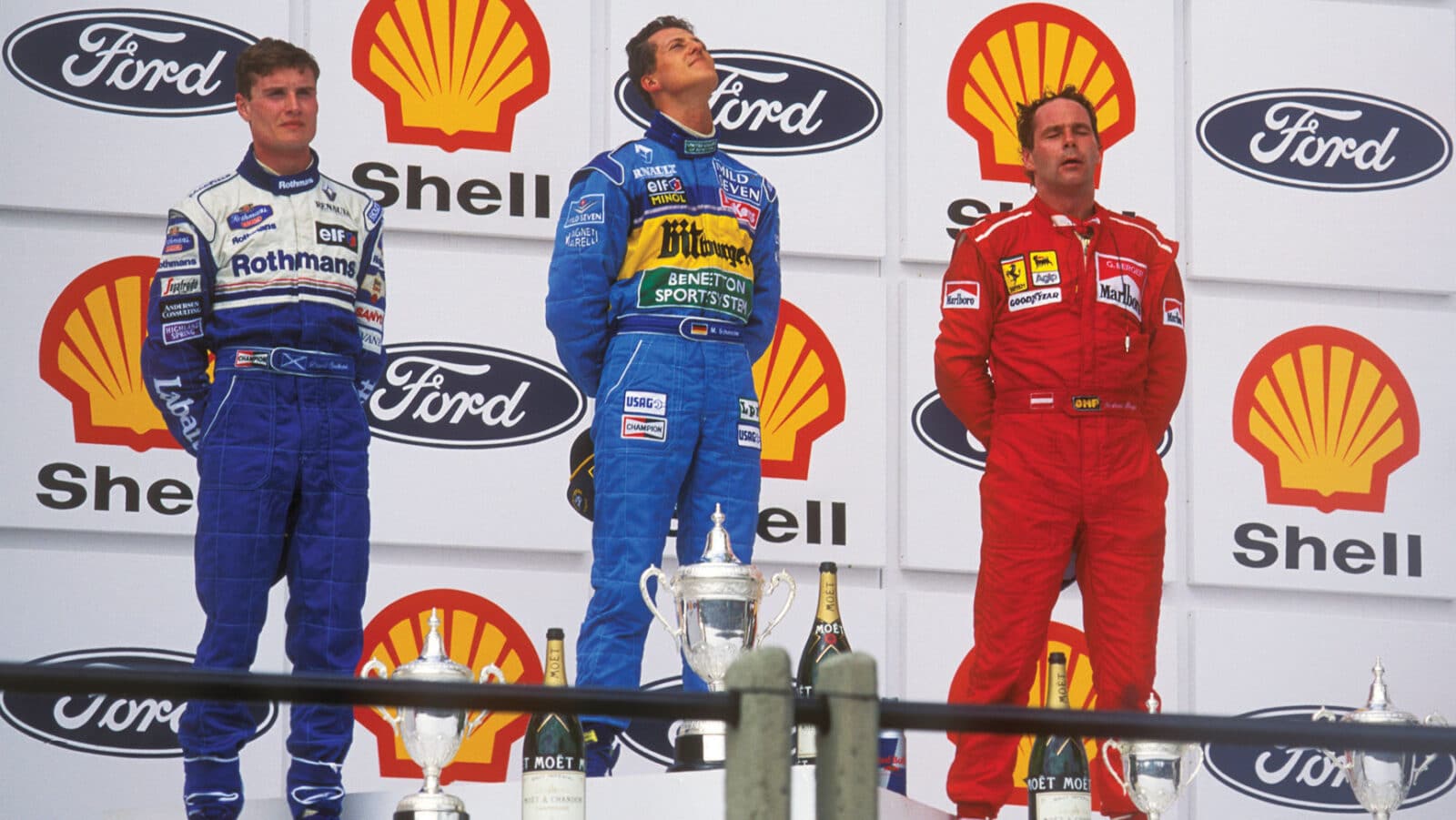Fat F1 drivers in 1995
Doug Nye recalls the season where grand prix racing’s finest filled out

Formula 1 heavyweights at the 1995 Brazilian GP... although those overalls hide the heft
Grand Prix Photo
It’s an unfortunate fact that rather more Formula 1 drivers are better remembered for misfortunes than achievement. For me 30 years ago the Japanese hopeful Taki Inoue fitted this bill.
During Saturday morning practice at Monaco in his Footwork-Hart FA16 he spun at Mirabeau and stalled. The car was wheeled aside then retrieved behind a tow truck during the break. Inoue had clambered back into the car’s cockpit to steer it home and ride the brakes to keep the towline taut. The little man hadn’t re-fastened his seatbelts.
As the truck was grumbling through the tunnel, and down through the chicane, the organisers sent out their course car. However, its driver that weekend was sparky rally ace Jean Ragnotti. Here he was upon the F1 world’s most exotic stage, and he set out to enjoy a lap and wow the fans. He squealed the car through the Casino Square, flashed downhill to Mirabeau, flickered round the Loews hairpin, drifted onto the seafront, boomed through the tunnel, barely blinked at the chicane and then – at what was described as “absurdly excessive speed” bulleted through Tabac, into the swimming pool complex and BAM! – straight into the back of the defenceless Inoue’s Footwork.
The impact launched the F1 car into a half-roll. It landed inverted, its unbelted driver falling out – fortunately still helmeted – onto the road beneath. A marshal friend who ran to assist helped him to his feet and found him “somewhat peeved” and unusually “round eyed”! Checked out at the medical centre the resilient racer proved uninjured, but was left under doctor’s orders not to drive again in qualifying, while being allowed to race next day.
The AC de Monaco was left with a gymnastic problem – quite how to settle with the understandably outraged Jackie Oliver of Footwork (Arrows) after their man Ragnotti’s spectacularly brainless bravado in the course car. That rumbled on for a while.
“Schumacher tipped the scales at 77kg – 8kg heavier than he’d been in ’94”
I guess it was the cameo sideshows like this that then made Formula 1 so absorbing. The irony of what today would be described as the ‘safety’ car being deployed in such a blatantly unsafe manner was not unique. Luckless Inoue must have felt he had a target pinned to his back when – three months later – he abandoned his Footwork at the Hungarian GP; as marshals assisted he grabbed an extinguisher and turned back to give it a squirt only to be walloped by the arriving course car. Infamy, infamy – they’ve all got it in for me?
Inoue survived as one of the most self-deprecating and pleasant of failed F1 hopes – a breed normally scarred and often embittered. Instead he has cheerfully described himself as having been the worst driver in Formula 1 – but, boy, that’s an assessment facing stiff competition.
From most arguably the worst – at least in terms of serial misfortune – to one of the supreme best, the F1 season of ’95 also got off to a contentious start with a great minimum weight snafu. At the season-opening Brazilian GP new regulations had been launched under which total weight of car and driver combined had to be 595kg – 1311.75lbs. Since the cars were to be weighed post-race without the driver seated, a heavier pre-registered driver weight offered benefits for a car actually racing (illegally) below that minimum weight.
It wasn’t quite a case of a driver being weighed for his registration with his overalls pockets bulging with spanners – but less obvious ploys could be adopted. At motor sport’s sharpest end any ploy is adoptable. The most creative rule benders then were undoubtedly Benetton and their star driver Michael Schumacher. For 1995 he tipped the scales at 77kg – 8kg (more than a stone) heavier than he’d been in ’94. When post-race he weighed 71.5kg – dispute! He protested he’d just muscled-up through winter training. His overalls looked no tighter. While both Heinz-Harald Frentzen and Gerhard Berger had registered weights 6.5kg higher than in ’94, post-race in Brazil both weighed the same.
FIA Technical Delegate Charlie Whiting had re-weighed Schumacher and his winning Benetton post-race, 595kg – legal.
There remained a small matter of fuel having to match the composition of a sample previously lodged with the FIA. The Elf race fuel burned by both Renault-powered Schumacher’s Benetton and David Coulthard’s second-placed Williams FW17 was found “non-compliant” – so both were disqualified. This left hefty Berger – plenty of mayo and fries? – who had finished third then suddenly first in his Ferrari 412T2.
Four days after the following Argentine GP – from which Berger emerged with a one-point Drivers’ Championship lead – an FIA court of appeal reinstated Schumacher and Coulthard’s Brazilian placings – the governing body’s agile lawyers explaining that while Benetton and Williams remained guilty of the offence as originally charged, the appeal court had – since there was evidence that different makes of gas chromatography fuel testing equipment could produce variable results –merely “changed the penalty applicable”.
The FIA’s history of legalistic fig-leafery continues. How refreshing in contrast to recall Bill France’s iron command of NASCAR racing. As its long-time dictator it was a case of “If I say it’s OK, boys, it’s OK – d’you wanna keep earnin’ – or not…?”. No fig leaves needed.
